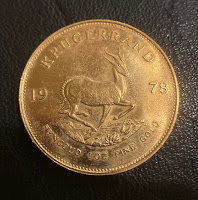My post from 4 weeks ago on the oil and Gold ideas has worked out pretty well at the one-month mark. See that post for below for the read if you missed it.
Generally, the oil ETF's recommended, FENY and XLE, gained 2.5% to 3.5%, while the individual stocks ran ahead more: Devon Energy, +6.6%, Halliburton, +8.6%, EOG Resources, +7.7%, and Conoco-Phillips was up 4.3%. The larger integrated oils, Exxon Mobile and Chevron fell about 1% each. Interestingly, the Crude Oil price fell during this period: from $119 to the current $102 or so. Oil traders must feel that the prospect of high prices (relative to expectations earlier), will hold up; so the stocks are bid up.
My post on the run-up in Gold prices was the exact top of the market, at least short term. Gold fell in price from $2,060 to $1,910 near March's end; then a small rally to today's $1,945. Our exchange-traded funds (PHYS, GLD, SGOL) fell 3.8% to 5.3% in the period.
Let's not forget about the general market for stocks, as you would have owned some stocks outside of the oil stocks. The S&P 500 rallied 7.5% and the Dow Jones added 6.4%.
You can slice and dice the numbers anyway you see fit, but I think adding or continuing to own a 10%-15% position in Gold and some oil stocks/ETF's may prove to continue adding value to your portfolio moving forward.
Gas prices have settled back to the $3.95-$4.10 area, so that helps also on the consumer price side.
The March inflation report will be released Tuesday morning. I expect another 'hot' number above 7% year-over-year. We'll see.
Thanks for reading.
Tuesday, March 8th, 2022
Gold and Oil prices have rose sharply both this year and since the Russian invasion of Ukraine on February 24th.
Crude
oil and gasoline prices rose well ahead of the war for varying reasons;
the war just exacerbated the rise as supply challenges lie ahead if we
cut off Russian supplied oil.
Gold
has risen, in my opinion, due to the political uncertainty with both
the war, and the high inflation - up 7.5% year over year - here in
America. Gold is seen as a safe haven when a lot of assets are behaving
poorly. Gold has proven to be a store of value for centuries. One way to look at investing is to own what is causing you the pain
in your daily living. Gas prices are moving higher; own a few oil
companies, or an index of oil and gas companies. Two I prefer are XLE
and FENY. XLE is the Energy Select Sector Fund. It holds energy and
exploration and drilling operators: Think Chevron, Exxon Mobil, Marathon
Oil, Halliburton, Devon Energy. FENY is the Fidelity Investments
version of XLE. It essentially owns the same stocks, as they both have
similar weightings in the big oil companies.
Both are exchange
traded - not mutual funds - so you can buy and sell them like stocks on
the New York Stock Exchange. If you prefer individual stocks for some
reason (taxes, dividends), you could buy the TOP 4 stocks in each
investment, and you would own half the exchange traded fund: Exxon Mobil
(XOM), Conono-Phillips (COP), Chevron (CVX) and EOG Resources (EOG).
Since the wars start, XLE is up 14%, while FENY gained 15%.
Gold sputtered last year, losing 4% in the bullion price, after two good years of +18% and +23% in 2019 and 2020. Stocks were the place to be then. This year, Gold has gained investors confidence again.

So,
as a diversified investor, let's recap the past couple of weeks with
Stocks, Bonds, Oil and Gold. (Feb. 23rd thru March 8th).
S&P 500 Index (stocks) ........... down 1.3%
Bonds (Long Term Treasury)..... up 1%
Oil and Gas Exchange Funds .... up 14%
Gold bullion / exchange Fund ... up 8%
Will
Gold and Oil hold onto their gains made the past month? We'll see. If
Gold and Oil do retreat, we look for stocks to move higher, or Bonds to
stablize. There are a lot of scenarios that COULD play out favorable for
Gold and Oil.
The
gas pump price above was what I paid Monday for the premium gas. It
costs me $0.20 a mile to move my SUV down the road at that price. So if I
can make a little money from my Gold and Oil stocks, maybe I can feel
(a bit) better at the pump next week ! Time will tell.
Thanks for reading!
Share as you so desire!
~Barry
P.S. If you type "GOLD" in the search box for this blog, you can view and read my other posts on Gold dating back a few years.





